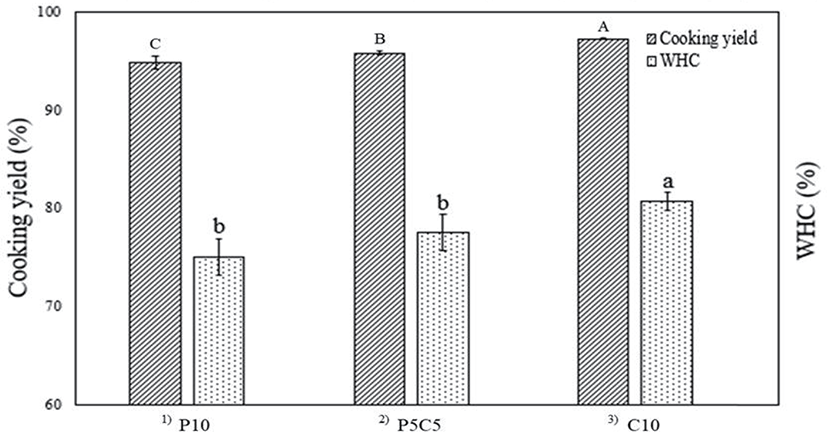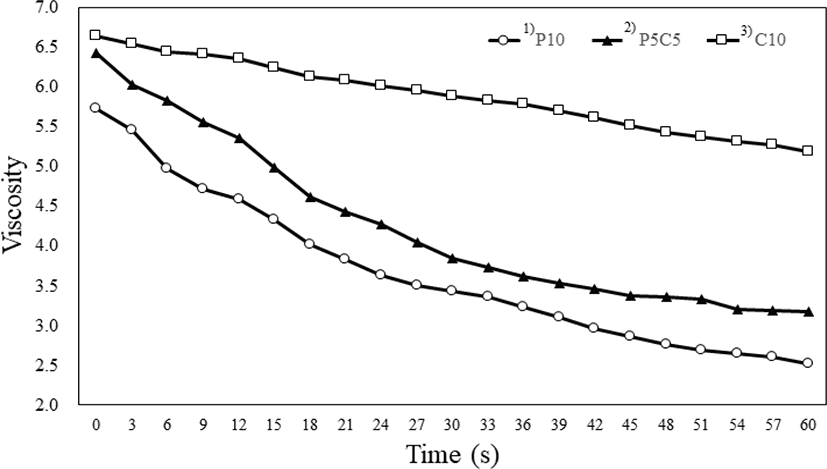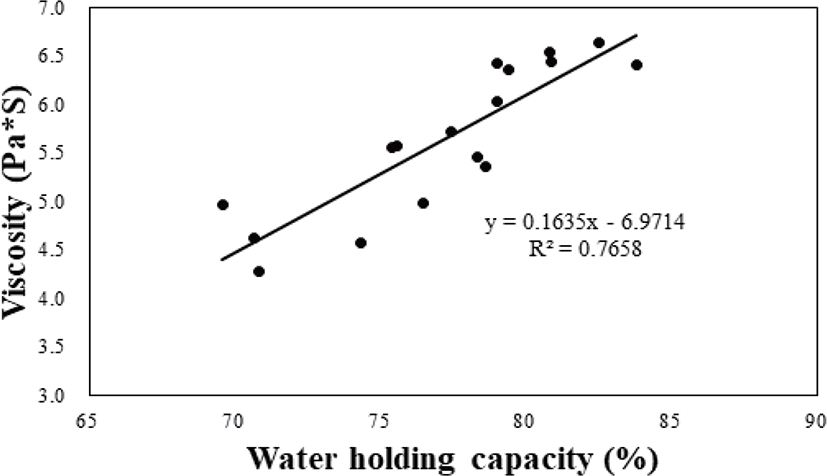INTRODUCTION
Processed fishery foods are categorized into dried, agar, paste, and seasoned products. Among them, fish paste products are often applied in home meal replacement (HMR) products, such as crab stick, crab meat, fish meat patty, and fish meat sausage [1]. Fish meat sausage is mainly produced using the washing method [2], although a variety of methods exists for the production of fish meat sausage in Korea. Pollack paste is increasingly consumed domestically and is frequently used in food production after removing the characteristic odor of fish meat [3].
Fish meat sausage is an emulsion-type product made using emulsified salt-soluble protein of fish muscle, fat, and heterogeneous proteins such as ISP (isolate soy protein), gelatin, etc. [4]. The quality of fish meat sausage is determined by its color, flavor, and elasticity, among which elasticity is the most important factor [5]. Elasticity can be altered by the quality of the main ingredient, fish species, type and amount of minor ingredients, and the cooking method. Researchers are currently investigating the potential use of new fish species other than the commonly used pollack, including common carp (Cyprinus carpio) and crucian carp (Carassius carassius) [6].
Crucian carp is a fish species of the family Carassius, order Cyprinidea, and class Cypriniformes. The species is widely distributed across the Eurasian continent and is known to survive in almost all rivers in Korea. Crucian carps contain a substance that inhibits various adult diseases and reduces indigestion and fatigue. Approximately 75% of the essential amino acids in crucian carp consist of histidine, glycine, and lysine, three free amino acids that strongly influence the palatability of fish meat [7]. In Korea, crucian carp has been used in various medicinal foods mainly in the form of steamed fish, porridge, or soup [8–10].
Crucian carp is low in fat content and high in moisture content and it can be used to make low-fat and low-calorie sausage in food industry. Therefore, this study aimed to supplement the disadvantages of pork by preparing fish meat sausage using crucian carp.
MATERIALS AND METHODS
The mixing ratio used to produce the fish meat sausage in this study is given in Table 1. The crucian carp (Carassius carassius) sample used in this study was obtained from the Wellbeing Fisheries in Chungcheongnam-do, Korea. The fish sample was stored at 2°C, and was prepared for the experiment within 12 h at the same temperature. The pork meat sample was taken from the rump, belly, and hock obtained 24 h after slaughter (NH hanaro, Yesan, Korea). The carp meat, pork meat, and back fat were ground using a grinder (PA-82, Mainca, Barcelona, Spain) to which a 3 mm plate was installed. Raw meat (60%), back fat (20%), and ice (20%) were finely cut using a bowl cutter (K-30, Talsa, Valencia, Spain), and the preparation involved the addition of 1.2% NPS, 1% ISP, 1% sugar, and 0.6% mixed spice per total weight. A filling device (EM-12, Mainca, Barcelona, Spain) was used to fill a natural pork intestine with the prepared emulsion, which was cooked for 30 min in an 80°C chamber (10.10ESI/SK, Alto Shaam, Menomonee Falls, WI, USA), followed by cooling for 20 min at 10°C. The resulting fish meat sausage was stored at 4°C for subsequent experiments.
| Ingredients | P10 | P5C5 | C10 |
|---|---|---|---|
| Main (%) | |||
| Meat | 60 | 30 | - |
| Carp | - | 30 | 60 |
| Fat | 20 | 20 | 20 |
| Ice | 20 | 20 | 20 |
| Additive (%) | |||
| NPS | 1.2 | 1.2 | 1.2 |
| Sugar | 1 | 1 | 1 |
| Mixed spice | 0.6 | 0.6 | 0.6 |
| ISP | 1 | 1 | 1 |
The approximate composition was measured based on the AOAC [11]. The Kjeldahl method was used to analyze crude protein content, the Soxhlet method was used to determine crude fat content, the oven-drying method (at 105°C) was used to analyze the moisture content, and the direct ashing method was used to assess the crude ash content.
Cooked and uncooked meat batters were mixed with distilled water in a 1:4 ratio using Ultraturax, and the pH of the diluted sample was measured using a pH meter (S220, Mettler-Toledo, Switzerland) with a pre-installed contact-type electrode (ROSS Ultra pH Electrode 8135BNUWP, Thermo Scientific, Waltham, MA, USA).
A colorimeter (CR 210, Minolta, Osaka, Japan) was used to measure the CIE L*, CIE a*, and CIE b* values of an inner cross-section of the sausage. A white standard plate with the following reference colors was used: +97.83 for CIE L*, −0.43 for CIE a*, and +1.98 for CIE b*.
The sample was weighed before cooking. Then, the meat was cooked for 30 min in a chamber set to 80°C, following which it was cooled for 20 min at room temperature (25°C). The cooking yield was calculated based on the sample weight before and after cooking using the following equation:
Three grams of sample were wrapped in a filter paper (Whatman No. 2) and placed in a conical tube for 10 min of centrifugation at 1,000 RPM in a centrifuge (Supra R22, Hanil, Daejeon, Korea). The WHC was calculated based on the sample weight before and after centrifugation, using the following equation:
A = [Weight before centrifugation (g) × Moisture content (%)] / 100
B = Weight before centrifugation (g) − Weight after centrifugation (g)
Here, the moisture content was estimated using the same method as the approximate composition.
The physical properties of the sample were measured using the texture analyzer (TA 1, Lloyd, FL, USA). The cooked sample was cut to 2.5 × 2.5 × 2.0 cm (width × length × height) in size, and the measurements were taken at room temperature. The following conditions were used for analysis: pre-test speed 2.0 mm/s, post-test speed 5.0 mm/s, maximum load 2 kg, head speed 2.0 mm/s, distance 8.0 mm, and force 5 g. A 25 mm cylinder probe was used for measurements. The measured hardness (kg), springiness, and cohesiveness were recorded, and based on the data, the gumminess (kg) and chewiness (kg) were estimated.
The viscosity of the emulsion sausage was measured using a rotary viscometer (Rheosys, Hamilton, NJ, USA. A 30 mm parallel plate with a 2.0 mm gap was installed and set to 20 RPM head speed to take measurements for 60 sec at 25°C.
All data were analyzed using Mixed model in SAS (version 9.3), and the results are expressed as mean values. Significant differences (p < 0.05) among the mean values were determined using ANOVA and Duncan’s multiple range test. The CORR procedure from the SAS package was used to calculate correlations between viscosity and cooking yield.
RESULTS AND DISCUSSION
Table 2 presents the approximate composition of the sausage based on the mixing ratio between the carp and pork meat. The moisture content was significantly higher in C10 than in other test groups (p < 0.05), likely due to the higher moisture content of carp meat than that of pork. The result agreed with that of Jin et al. [12], where the meat of the surimi fish had high moisture content at 80.09%–80.56%. The protein content was significantly lower in C10 than in other test groups (p < 0.05), likely because the higher moisture content of carp meat led to a relatively lower protein content. The fat content was the highest in P5C5 (p < 0.05), while C10 had the lowest fat content. This may be attributed to the low fat content of fish meat itself [13]. The ash content was significantly high in both P5C5 and C10 (p < 0.05), which is thought to be caused by the inherent high content of minerals in fish meat [14].
| Traits | P10 | P5C5 | C10 | SEM |
|---|---|---|---|---|
| Moisture content (%) | 61.86b | 63.14b | 65.46a | 1.76 |
| Protein content (%) | 14.84a | 14.58a | 13.41b | 0.63 |
| Fat content (%) | 16.35b | 18.30a | 14.24c | 1.91 |
| Ash content (%) | 1.56b | 1.99a | 1.93a | 0.32 |
Table 3 presents the pH and color of the sausage based on the mixing ratio between the carp and pork meat. The pH of samples before and after cooking increased with increase in carp content, with C10 displaying significantly higher pH values than other test groups (p < 0.05). This may be accounted for by the pH of carp (7.23), which is higher than the pH of pork (5.9) after rigor mortis, as reported by Bendall and Swatland [15]. The pH of the sausage was higher after cooking than before cooking, which was previously reported to be due to the mass release of cations from amino acid residues following protein heat denaturation [16].
The lightness before and after cooking was significantly higher in the two groups with carp than in the pork-only group (p < 0.05), likely because carp muscle is a white muscle with low content of myoglobin [17]. The yellowness before and after cooking was significantly higher in the pork-only group than in those with carp, and was inversely proportional to the content of red meat (p<0.05). The redness of the sausage after cooking decreased with increasing carp content, because carp muscle is low in nitroso-myoglobin content. P5C5 had the highest value of yellowness after cooking, and was significantly different from P10. The result is consistent with that of Yoon et al. [18], in which lightness and yellowness increased in steak after the addition of white flounder meat.
Fig. 1 shows the WHC and cooking yield of the sausage based on the mixing ratio between the carp and pork meat. The highest WHC was found in C10 compared to other test groups (p < 0.05). Although red meat has an abundance of sarcoplasmic proteins in comparison to white meat [19], the pH of C10 (6.67) led to a greater change away from the isoelectric point upon a high level of WHC, which may explain this result. Conversely, P5C5 and P10 did not show a significant difference, and C10 showed significantly higher results than other test groups. When a small amount of edible salt is added to fish meat that consists of muscle fibers, myofibrils, and acto-myosin filaments, the myosin constituting the myofibrils undergoes isolation to allow for a high level of binding [20]. This might be the reason why C10, which contained fish meat, showed the highest WHC value.

The cooking yield was significantly lower in P10 than in C10 (p < 0.05), and C10 had a higher value than P5C5. This is probably due to the higher WHC of the red muscle in pork meat compared to that of the white muscle in carp meat, leading to stronger binding among the water molecules in the carp proteins than in pork proteins, consequently increasing the cooking yield.
Kristinsson and Rasco [21] reported that fish protein hydrolysates have high solubility, water retention ability, emulsification, and foam-forming ability. Thus, it is considered that the pork sausage added with fish meat can have improved WHC and cooking yield due to gelation of protein.
Most fluids are characterized by non-Newtonian viscosity, which is divided into pseudoplastic, dilatant, and thixotropic. The viscosity of the sausage as determined by the mixing ratio between the carp and pork meat (Fig. 2) corresponds to time-dependent thixotropic viscosity [22]. C10 had a higher value than P5C5, which itself had a higher value than P10. This is due to the inherent gelation ability of the carp muscle and the combining ability of sausage based on viscoelasticity [23], which is a critical property relating to the quality of fish meat paste products. It is thus anticipated that a product with enhanced binding and texture properties may be produced by adding carp meat.

Table 4 presents the results of TPA for the sausages based on the mixing ratio between the carp and pork meat. In the texture profile of the fish meat sausages, elasticity is the most important factor [24]. Springiness increased as the carp meat content increased, and a significant difference was found between P10 and C10 (p < 0.05). This is presumed to be caused by the higher moisture content in carp meat than in pork meat. P10 sausages had significantly higher gumminess and chewiness values than those containing carp meat, likely due to the influence of hardness [25]. Further, P10 and C10 had significantly higher cohesiveness values than P5C5. Based on the findings of this study, a fish meat sausage product can be produced to resemble the existing products, but with higher WHC due to the reticular structure of carp protein, and with enhanced elasticity.
Fig. 3 shows the correlation between WHC and viscosity of the sausage based on the mixing ratio between the carp and pork meat. With increased emulsion viscosity in the pork and carp meat, the WHC had an increasing trend (R2 = 0.7658) and a high correlation, followed by an increase towards a proportional relationship. According to Huff-Lonergan and Lonergan [27], the WHC as an ability to retain moisture is the most important factor in maintaining the physicochemical quality. In addition, viscosity is influenced by the shape of the salt soluble protein, which reportedly has a significant impact on the maintenance of the overall shape of the sausage [28]. Thus, it is anticipated that a product of outstanding quality can be developed by adding carp meat based on the proportional increase in WHC and viscosity.

CONCLUSION
The results of this research suggest that carp meat can enhance the quality of emulsion sausages. Carp muscle not only improved cooking yield, but also enhanced viscosity and texture profile analysis because of its high WHC. Therefore, sausages may be manufactured with carp meat to supplement or overcome the disadvantages of pork.
















